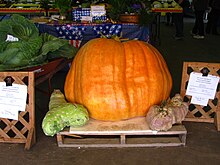
Agriculture in Alaska faces many challenges, largely due to the climate, the short growing season, and generally poor soils. However, the exceptionally long days of summer enable some vegetables to attain world record sizes.
Farms[edit]
The state of Alaska contains some 500 farms, covering about 830,000 acres in 2015,[1] mainly to the northeast of the state's largest city, Anchorage, in the Matanuska Valley. The farms produce greenhouse and nursery crops, as well as hay (20,000 tons), dairy produce, potatoes (140,000 cwt), and livestock including cattle (11,000 inc. calves in 2016), reindeer, bison, and yak.[2] Cereals in the state include barley (146,000 bushels) and oats (47,000 bushels). Other livestock include chickens, hogs, and sheep. By value, the top livestock commodities in 2015 were milk ($770,000), eggs, and beef in that order.[3][1]

The exceptionally long summer days enable some vegetables to attain world record sizes, including a carrot of 19 pounds (8.6 kg), a rutabaga of 76 pounds (34 kg), and a cabbage of 127 pounds (58 kg).[2]
Alaska was the third US state to legalize recreational cannabis use. Due to the specific light and temperature needs of cannabis, much of the farming is done indoors.
Alaskan soils[edit]
Alaskan soil conditions range from loamy to sandy, with all ranges in between. In many parts of Alaska, the soil is acidic, and could greatly improve with the introduction of lime or wood ash. The biomes range from tundra, which is rich in underlying peat moss to taiga, boreal forest, and temperate rain forest. Because Alaska was once dominated by glaciers, much of the underlying subsurface is glacial till, silt and sand.
The official state soil is the Tanana series, which is shallow, well drained, moderately permeable, and derived from limestone weathering. It is a coarse loam, cryoturbated to a depth of up to 72 inches (1.8 m).[4]
See also[edit]
References[edit]
- ^ a b "2015 STATE AGRICULTURE OVERVIEW". USDA. Retrieved 27 November 2016.
- ^ a b "Alaska Agriculture". Retrieved 27 November 2016.
- ^ "Alaska Economy". Netstate. Retrieved 27 November 2016.
- ^ "Tanana Series". USDA. Retrieved 27 November 2016.
